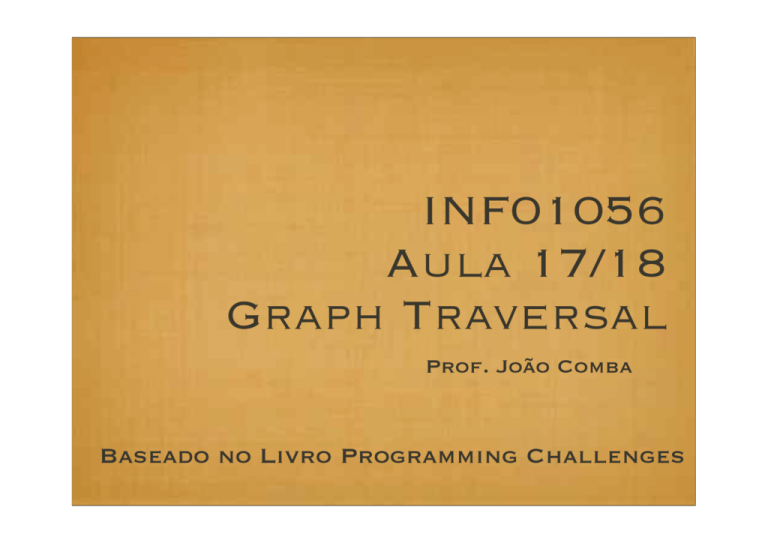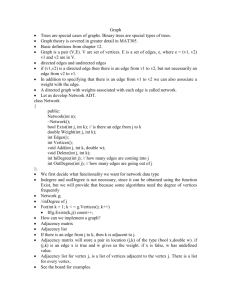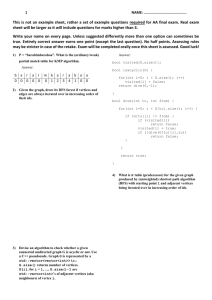INF01056 Aula 17/18 Graph Traversal
advertisement

INF01056
Aula 17/18
Graph Traversal
Prof. João Comba
Baseado no Livro Programming Challenges
Outline
Graph Types
Data Structures
Breadth-First Search
Depth-First Search
Topological Sort
Graph Types
Undirected vs Directed
Weighted vs Unweighted
Cyclic vs Acyclic
Simple vs Non-Simple
Embedded vs Topological
Implicit vc Explicit
Labeled vs Unlabeled
G = (V, E)
Outline
Graph Types
Data Structures
Breadth-First Search
Depth-First Search
Topological Sort
Data Structures
Adjacency Matrix
Adjacency Lists in Lists
Adjacency Lists in Matrices
Table of Edges
Data Structures
#define!MAXV! ! 100!! /* maximum number of vertices */
#define MAXDEGREE!
50! /* maximum outdegree of a vertex */
typedef struct {
! int edges[MAXV+1][MAXDEGREE];! /* adjacency info */
! int degree[MAXV+1];!
! /* outdegree of each vertex */
! int nvertices;! ! ! /* number of vertices in the graph */
! int nedges;!! ! /* number of edges in the graph */
} graph;
Data Structures
#include "queue.h"
#include "graph.h"
initialize_graph(graph *g) {
! int i;! ! ! ! /* counter */
!
!
!
}
g -> nvertices = 0;
g -> nedges = 0;
for (i=1; i<=MAXV; i++) g->degree[i] = 0;
read_graph(graph
! int i;! ! !
! int m;! ! !
! int x, y;! !
*g, bool directed) {
! /* counter */
! /* number of edges */
! /* vertices in edge (x,y) */
initialize_graph(g);
!
scanf("%d %d",&(g->nvertices),&m);
!
!
!
for (i=1; i<=m; i++) {
! scanf("%d %d",&x,&y);
! insert_edge(g,x,y,directed);
}
}
Data Structures
insert_edge(graph *g, int x, int y, bool directed) {
! if (g->degree[x] > MAXDEGREE)
!
printf("Warning: insertion(%d,%d) exceeds max degree\n",x,y);
g->edges[x][g->degree[x]] = y;
g->degree[x] ++;
!
!
}
if (directed == FALSE) insert_edge(g,y,x,TRUE);
else g->nedges ++;
delete_edge(graph *g, int x, int y, bool directed) {
! int i;! ! ! ! /* counter */
!
!
!
!
!
!
!
for (i=0; i<g->degree[x]; i++)
! if (g->edges[x][i] == y) {
! ! g->degree[x] --;
! ! g->edges[x][i] = g->edges[x][g->degree[x]];
! ! if (directed == FALSE)
! ! ! delete_edge(g,y,x,TRUE);
! ! return;
}
!
}
printf("Warning: deletion(%d,%d) not found in g.\n",x,y);
Data Structures
print_graph(graph *g) {
! int i,j;! ! ! /* counters */
!
!
!
!
!
}
for (i=1; i<=g->nvertices; i++) {
! printf("%d: ",i);
! for (j=0; j<g->degree[i]; j++)
! ! printf(" %d",g->edges[i][j]);
! printf("\n");
}
Outline
Graph Types
Data Structures
Breadth-First Search
Depth-First Search
Topological Sort
Breadth-First Search
bool processed[MAXV];!
/* which vertices have been processed */
bool discovered[MAXV]; /* which vertices have been found */
int parent[MAXV];! /* discovery relation */
bool finished = FALSE;! /* if true, cut off search immediately */
initialize_search(graph *g) {
int i; /* counter */
for (i=1; i<=g->nvertices; i++) {
processed[i] = discovered[i] = FALSE;
parent[i] = -1;
}
}
Breadth-First Search
bfs(graph *g, int start) {
! queue q;!! ! /* queue of vertices to visit */
! int v;!
! ! ! /* current vertex */
! int i;!
! ! ! /* counter */
!
!
!
!
!
!
!
!
!
!
}
init_queue(&q);
enqueue(&q,start);
discovered[start] = TRUE;
while (empty(&q) == FALSE) {
v = dequeue(&q);
! process_vertex(v);
! processed[v] = TRUE;
! for (i=0; i<g->degree[v]; i++)
!
if (valid_edge(g->edges[v][i]) == TRUE) {
! !
if (discovered[g->edges[v][i]] == FALSE) {
enqueue(&q,g->edges[v][i]);
discovered[g->edges[v][i]] = TRUE;
parent[g->edges[v][i]] = v;
}
!
if (processed[g->edges[v][i]] == FALSE)
process_edge(v,g->edges[v][i]);
!
}
}
Breadth-First Search
extern bool processed[];! /* which vertices have been processed */
extern bool discovered[];! /* which vertices have been found */
extern int parent[];! ! /* discovery relation */
process_vertex(int v) {
! printf("processed vertex %d\n",v);
}
process_edge(int x, int y) {
printf("processed edge (%d,%d)\n",x,y);
}
bool valid_edge(int e) {
return (TRUE);
}
Breadth-First Search
9.3. Graph Traversal: Breadth-First
13
14
15
16
13
14
15
16
9
10
11
12
9
10
11
12
5
6
7
8
5
6
7
8
1
2
3
4
1
2
3
4
197
Figure 9.1. An undirected 4 × 4 grid-graph (l), with the DAG defined by edges going to
higher-numbered vertices (r).
Since this is the reverse of how we normally want the path, we can either (1) store it
Breadth-First Search
main() {
! graph g;
! int i;
! read_graph(&g,FALSE);
print_graph(&g);
! initialize_search(&g);
! bfs(&g,1);
! for (i=1; i<=g.nvertices; i++)
! ! printf(" %d",parent[i]);
! printf("\n");
! for (i=1; i<=g.nvertices; i++)
! ! find_path(1,i,parent);
! printf("\n");
}
Figure 9.1. An undirected 4 × 4 grid-graph (l), with the DAG defined by edges going to
higher-numbered vertices (r).
Breadth-First Search
9.3. Graph Traversal: Breadth-First
Since this is the reverse of how we normally want the path, we can either (1) store it
and then explicitly reverse it using a stack, or (2) let recursion reverse it for us, as in
13
14
15
16
13
14
15
16
the following slick routine:
find_path(int start, int end, int parents[])
{
9
10
11
10
if ((start
== end)
|| (end12 == -1)) 9
printf("\n%d",start);
else {
find_path(start,parents[end],parents);
5
6
5
6
printf(" 7%d",end);8
}
}
11
12
7
8
197
2 example 3(Figure 9.1)4 our algorithm
1
2
3
On 1our grid graph
generated
the following
parent4
relation:
Figure 9.1. An undirected 4 × 4 grid-graph (l), with the DAG defined by edges going to
vertex
1
2 3 4 5 6 7 8 9 10 11 12 13 14 15 16
higher-numbered
vertices
(r).
parent
-1
1
2
3
1
2
3
4
5
6
7
8
9
10
11
12
For the shortest path from the lower-left corner of the grid to the upper-right corner,
this parent relation yields the path {1, 2, 3, 4, 8, 12, 16}. Of course, this shortest path is
Since
is the
reverse of
ofsuch
howpaths
we normally
want
the path,
we can6.3.
either (1) store it
not this
unique;
the number
in this graph
is counted
in Section
Outline
Graph Types
Data Structures
Breadth-First Search
Depth-First Search
Topological Sort
Depth-First Search
dfs(graph *g, int v) {
! int i;! ! ! ! /* counter */
! int y;! ! ! ! /* successor vertex */
!
if (finished) return;! !
!
discovered[v] = TRUE;
process_vertex(v);
!
!
!
!
for (i=0; i<g->degree[v]; i++) {
! y = g->edges[v][i];
! if (valid_edge(g->edges[v][i]) == TRUE) {
! ! if (discovered[y] == FALSE) {
parent[y] = v;
! ! ! dfs(g,y);
! ! } else
! ! ! if (processed[y] == FALSE)
process_edge(v,y);
}
! if (finished) return;
}
processed[v] = TRUE;
!
!
!
!
!
}
/* allow for search termination */
Finding Cycles
extern bool processed[];! /* which vertices have been processed */
extern bool discovered[];! /* which vertices have been found */
extern int parent[];! ! /* discovery relation */
extern bool finished;!! /* flag for early search cutoff */
process_vertex(int v) { }
process_edge(int x, int y) {
! if (parent[x] != y) {!/* found back edge! */
! ! printf("Cycle from %d to %d:",y,x);
find_path(y,x,parent);
! ! printf("\n\n");
! ! finished = TRUE;
}
}
bool valid_edge(int e) {
return (TRUE);
}
Connected Components
process_vertex(int v) {
! printf(" %d",v);
}
process_edge(int x, int y) { }
bool valid_edge(int e) {
return (TRUE);
}
connected_components(graph *g) {
! int c;! ! ! ! /* component number */
! int i;! ! ! ! /* counter */
initialize_search(g);
!
!
!
!
!
!
}
c = 0;
for (i=1; i<=g->nvertices; i++)
! if (discovered[i] == FALSE) {
! ! c = c+1;
! ! printf("Component %d:",c);
dfs(g,i);
! ! printf("\n");
}
Outline
Graph Types
Data Structures
Breadth-First Search
Depth-First Search
Topological Sort
Topological Sort
#include "graph.h"
#include "queue.h"
compute_indegrees(graph *g, int in[]) {
! int i,j;! ! ! /* counters */
! for (i=1; i<=g->nvertices; i++) in[i] = 0;
! for (i=1; i<=g->nvertices; i++)
! ! for (j=0; j<g->degree[i]; j++) in[g->edges[i][j]]++;
}
Topological Sort
topsort(graph *g, int sorted[]) {
! int indegree[MAXV];!! /* indegree of each vertex */
! queue zeroin;! ! ! /* vertices of indegree 0 */
! int x, y;! ! ! /* current and next vertex */
! int i, j;! ! ! /* counters */
!
compute_indegrees(g,indegree);
init_queue(&zeroin);
! for (i=1; i<=g->nvertices; i++)
! ! if (indegree[i] == 0) enqueue(&zeroin,i);
!
!
!
!
!
!
!
!
!
!
!
}
j=0;
while (empty(&zeroin) == FALSE) {
! j = j+1;
! x = dequeue(&zeroin);
! sorted[j] = x;
! for (i=0; i<g->degree[x]; i++) {
! ! y = g->edges[x][i];
! ! indegree[y] --;
! ! if (indegree[y] == 0) enqueue(&zeroin,y);
}
}
if (j != g->nvertices)
! printf("Not a DAG -- only %d vertices found\n",j);
Bicoloring
#include <iostream>
using namespace std;
int cores[200];
bool mat[200][200];
int n;
bool dfs(int src, int cor) {
cores[src] = cor;
!
int nova = 3-cor;!
!
for (int i=0; i<n; ++i) {
!
!
if (!mat[src][i])
!
!
!
continue;
!
!
if (cores[i] == cor)
!
!
!
return false;!
!
!
!
if (cores[i] == nova)
!
!
!
continue;!
!
!
!
if (!dfs(i, nova))
!
!
!
return false;
}
!
return true;
}
}
Bicoloring
int
!
!
!
!
!
!
!
main() {
while (cin >> n && n) {
!
int e, s, d;
!
cin >> e;
!
for (int i=0; i<n; ++i) {
!
!
cores[i] = 0;
!
!
for (int j=0; j<n; ++j)
!
!
!
mat[i][j] = false;
}
!
!
!
!
!
!
!
!
for
!
!
!
}
!
!
!
!
!
!
!
!
}
if (dfs(0, 1))
!
cout << "BICOLORABLE." << endl;
else
!
cout << "NOT BICOLORABLE." << endl;
}
(int i=0; i<e; ++i) {
cin >> s >> d;
mat[s][d] = true;
mat[d][s] = true;







